Air compressors are great for various tasks, from filling up tires to powering tools. To prevent accidents and injuries, how to use an air compressor safely is important.
First and foremost, always read the owner’s manual and follow the manufacturer’s instructions. Before using the compressor, inspect it for any damage or leaks. Ensure all connections are secure and tight and the pressure relief valve functions properly.
When using the compressor, wear appropriate personal protective equipment, such as safety glasses, gloves, and ear protection. In addition, never exceed the recommended pressure level for your tools or equipment. Ensure that the area is well-ventilated if you are using the compressor indoors to prevent the buildup of fumes
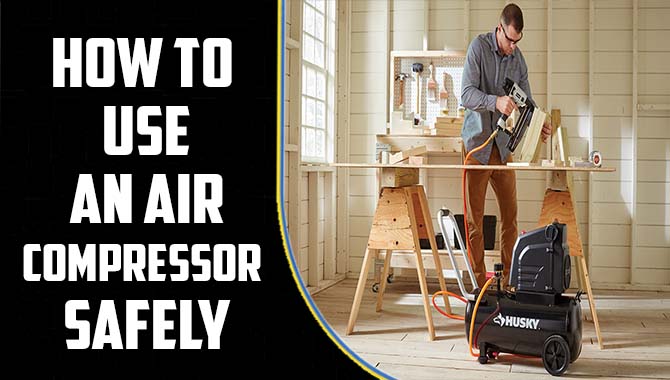
What Is Air Compressor Safety?

Air compressor safety is a critical aspect of using any compressed air equipment. Compressed air is a powerful tool that can cause serious injuries if not used properly. Therefore, understanding air compressor safety is crucial to prevent accidents and maintain optimal performance.
The first step in air compressor safety is to read and understand the manufacturer’s instructions before operating the equipment. This includes knowing the maximum pressure rating and the type of hose and connectors needed.
Furthermore, proper maintenance of the compressor is essential to ensure its longevity, reliability, and safety. Regular check-ups of the compressor’s components, including the safety release valve and pressure gauges, can help detect issues before they become a hazard.
Tips For Using Air Compressors Safely

Air compressors are powerful machines that can be incredibly useful for a variety of tasks, but they can also pose significant risks if not used correctly. So here are some tips on how to use an air compressor safely.
- Always read and follow the manufacturer’s instructions carefully. These instructions will include important information about the specific model you are using, including any safety precautions that you should take.
- Wearing appropriate personal protective equipment, such as safety glasses and ear protection, is important when using an air compressor. Ensure that you ground the compressor properly and secure any hoses or connections when operating it. Always avoid using a damaged or worn compressor to reduce the risk of injury.
- Always be aware of the pressure rating of the tools you use with the compressor, as exceeding this rating can also be dangerous.
Safety Precautions Before Starting An Air Compressor

Before operating an air compressor, it is important to take certain safety precautions to avoid accidents and injuries. Firstly, place the compressor on a stable and level surface and properly ground it. Inspect the electrical cords and hoses for any damage before plugging them in.
You should wear appropriate personal protective equipment such as safety glasses, hearing protection, and gloves. You should wear appropriate personal protective equipment such as safety glasses, hearing protection, and gloves.
Always follow the manufacturer’s instructions and do not exceed the recommended pressure level for the compressor. When using air tools, ensure you properly attach and secure them to the hose and do not point them at yourself or others. Finally, keep the work area clean and free of any debris or obstacles that could cause tripping hazards.
How To Use An Air Compressor
An air compressor can be handy for various tasks, from inflating tires to powering pneumatic tools. However, knowing how to use an air compressor safely and effectively is important.
First, ensure you have the right type of compressor for your needs – a small portable unit is great for household tasks, while a larger stationary unit is better for industrial applications. Before using the compressor, check the oil level and ensure the tank is drained of accumulated water.
Next, connect the air hose to the compressor and the tool or accessory you’ll be using. Adjust the pressure regulator to the appropriate level for your task, and turn on the compressor. As the tank fills with air, you’ll hear the motor running – once it reaches the desired pressure, it will shut off automatically. Be sure to use appropriate safety gear, including eye and ear protection, when using an air compressor.
How To Use An Air Compressor Safely To Fill A Tire
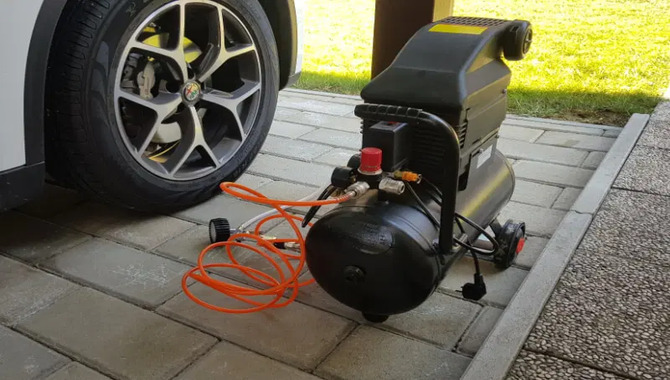
An air compressor is a useful tool for filling up a tire quickly and efficiently. However, it’s important to know how to use it safely to prevent any accidents or injuries. First, ensure the air compressor is properly grounded and all safety features, such as pressure relief valves, are working correctly.
Next, attach the hose to the tire valve stem and turn on the compressor. Be sure to stand clear of the hose and tire while filling, as overinflated tires can explode. Keep an eye on the pressure gauge and stop filling once the tire reaches the recommended pressure level. If the compressor has been running for an extended period of time, allow it to cool down before turning it off and disconnecting the hose.
Always wear protective eyewear and earplugs when using an air compressor, as the noise and debris can be hazardous to your health. With these safety tips in mind, you can safely and effectively use an air compressor to fill your tires.
How To Use An Air Compressor Safely On Your Flat Tire
- Park in a safe location: Find a safe and level area to park your vehicle away from traffic. Engage the parking brake and turn off the engine.
- Read the manual: Familiarize yourself with the specific instructions provided in the air compressor’s user manual, especially regarding tire inflation.
- Wear safety gear: Wear safety glasses and consider wearing gloves to protect your hands during the process.
- Inspect the compressor: Check the air compressor for visible damage or leaks. Ensure that it is in good working condition before proceeding.
- Connect the compressor: Attach the air hose securely to the air compressor. Confirm that the hose connection is tight and free of leaks.
- Connect to the tire valve: Remove the cap from the flat tire’s valve stem. Attach the air chuck firmly onto the valve stem. Ensure a proper seal to prevent air leakage.
- Set the pressure: Consult your vehicle’s recommended tire pressure, usually found in the owner’s manual or inside the driver’s door jamb. Set the air compressor’s pressure gauge to the desired level.
- Power on the compressor: Plug in the air compressor and turn it on. Allow the compressor to build up pressure until it automatically shuts off, or follow the instructions provided in the user manual.
- Inflate the tire: Keep a close eye on the pressure gauge while inflating the tire. Do not exceed the recommended tire pressure. Pause periodically to check the tire’s pressure with a separate gauge for accuracy.
- Monitor the tire: Once the desired tire pressure is reached, turn off the air compressor and disconnect the air chuck from the valve stem. Reinstall the valve cap on the tire.
How To Use Air Compressors Safely For Tires At A Gas Station
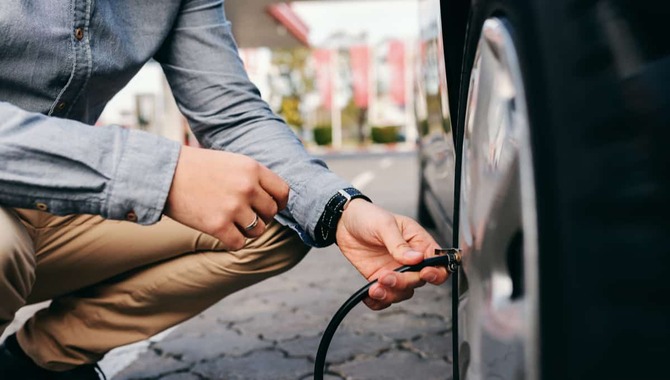
Air compressors are commonly found at gas stations and are a convenient way to inflate tires. However, it is important to use them safely to avoid accidents and damage to your vehicle. Before using the air compressor, ensure that the tire pressure recommended by the manufacturer is displayed on the tire or in the owner’s manual.
Next, check the air pressure in the tire using a tire gauge to ensure that it is not overinflated. Overinflated tires can cause blowouts while driving, so it is important to get the right pressure. Once you have verified the right pressure, you can connect the air hose to the tire valve stem and turn on the compressor.
Keep an eye on the pressure gauge and stop inflating once the desired pressure is reached. It is important never to leave the air compressor unattended while in use and never to overinflate the tire. Overinflated tires can cause reduced traction, uneven wear, and blowouts while driving.
Air Compressor Safety Hazards
Air compressors are essential in many industries, but they can pose serious safety hazards if not used properly. One of the most common hazards is the risk of injury from the high-pressure air stream. This can cause serious cuts, bruises, and even amputations if the air stream is directed toward a person’s body.
To prevent this, never point the air compressor nozzle at anyone or use compressed air to clean clothing or body parts. Another safety hazard associated with air compressors is the risk of explosion or fire due to improperly maintained equipment or filling the compressor with the wrong type of oil.
To prevent this, it is important to follow the manufacturer’s instructions for maintenance and ensure that a qualified technician regularly inspects the compressor. Additionally, the compressor should be placed in a well-ventilated area away from flammable materials.
Conclusion
How to Use an air compressor safely requires following specific guidelines and precautions. By reading the manual, wearing appropriate safety gear, inspecting the compressor, setting the pressure correctly, securely connecting hoses and tools, ensuring proper ventilation, directing airflow safely, conducting regular maintenance, and following safety guidelines, you can minimize the risks associated with air compressor operation.
Prioritizing safety, being aware of potential hazards, and using the compressor responsibly is essential for a safe and productive air compressor experience.
FAQs
1.What Safety Gear Should I Wear When Using An Air Compressor?
Ans: Wear safety glasses, hearing protection, gloves, and respiratory protection if necessary.
2.Can I Use An Air Compressor With Damaged Or Leaking Parts?
Ans: No, never use a damaged or malfunctioning air compressor. It should be repaired or replaced before use.
3.How Do I Set The Correct Pressure On An Air Compressor?
Ans: Consult the recommended tire pressure for your task and adjust the pressure regulator accordingly.
4.Can I Use An Air Compressor In A Confined Space?
Ans: If using in an enclosed space, ensure proper ventilation to prevent the buildup of fumes or gases.
5.Is It Important To Check For Air Leaks In The Hose Connections?
Ans: Yes, ensure all connections are secure and free from leaks by using a soapy water solution to detect bubbles.


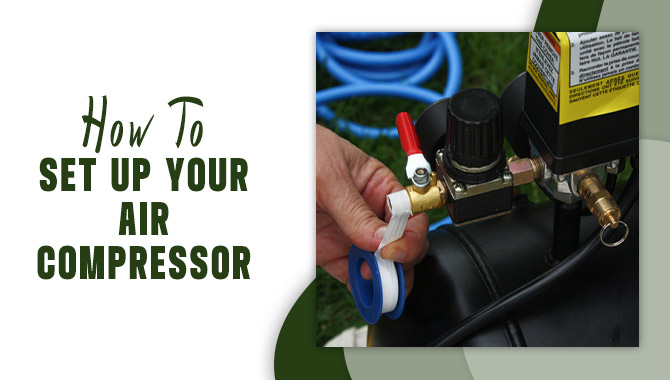

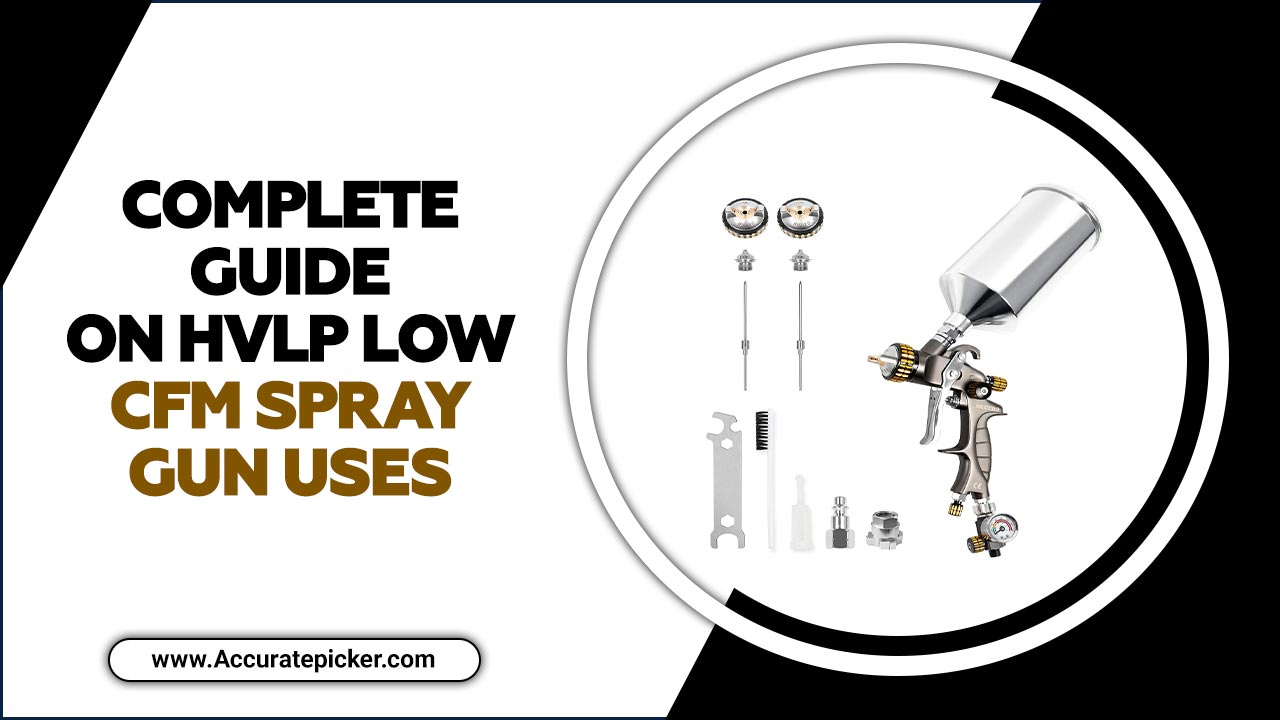
![7 Best Spray Gun For Small Compressor [Reviews With Buying Guide]](https://accuratepicker.com/wp-content/uploads/2023/07/Best-Spray-Gun-For-Small-Compressors.jpg)